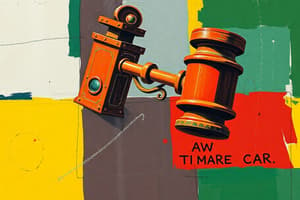Podcast
Questions and Answers
In the context of Lex Aquilia, which element must be present to establish liability for a delict?
In the context of Lex Aquilia, which element must be present to establish liability for a delict?
- The perpetrator must have directly benefited financially from the action.
- A loss or harm (damnum) must have occurred as a direct result of the action. (correct)
- The action must have been pre-meditated and carefully planned.
- The perpetrator must have acted with malicious intent.
Which of the following scenarios is best categorized as 'Damnum Iniuria Datum' under the Law of Torts?
Which of the following scenarios is best categorized as 'Damnum Iniuria Datum' under the Law of Torts?
- Breaking into a house and stealing valuable items while the owners are away.
- Accidentally scratching a parked car while trying to parallel park.
- Vandalizing a public monument by painting graffiti on it. (correct)
- Intentionally spreading false rumors about a competitor to damage their business reputation.
A person shoplifts an item from a store. According to the examples of delicts, which category does this action fall under?
A person shoplifts an item from a store. According to the examples of delicts, which category does this action fall under?
- Damnum Iniuria Datum
- Injuria
- Rapina
- Furtum (correct)
In a scenario where a person damages another's property, but not intentionally, which element of liability under Lex Aquilia would be most challenging to establish?
In a scenario where a person damages another's property, but not intentionally, which element of liability under Lex Aquilia would be most challenging to establish?
How does 'rapina' differ from 'furtum' in the context of delicts?
How does 'rapina' differ from 'furtum' in the context of delicts?
Flashcards
Law of Torts (Delict)
Law of Torts (Delict)
The area of law dealing with civil wrongs where a person suffers loss or harm, leading to legal liability.
Lex Aquilia (286 BCE)
Lex Aquilia (286 BCE)
A Roman law that introduced the concepts of fault, damage, and a causal link as essential to establish liability.
Fault (Culpa)
Fault (Culpa)
The person committing the delict must be at fault; there must be blameworthy conduct.
Damage (Damnum)
Damage (Damnum)
Signup and view all the flashcards
Causal Link
Causal Link
Signup and view all the flashcards
Study Notes
- The Law of Torts (Delict)
- Lex Aquilia (286 BCE) introduced three key elements of liability.
Key Elements of Liability
- Fault (Culpa): The person must be at fault.
- Damage (Damnum): A loss must have occurred.
- Causal Link: A causal connection.
Examples of Delicts:
- Furtum: Stealing property.
- Rapina: Theft with violence.
- Injuria: Harming someone’s dignity.
- Damnum Iniuria Datum: Causing wrongful damage to property.
Studying That Suits You
Use AI to generate personalized quizzes and flashcards to suit your learning preferences.




